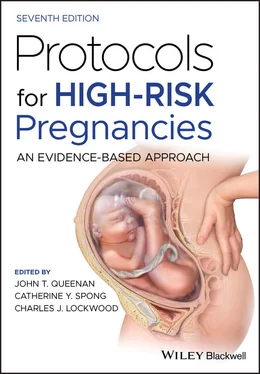Patients can be initiated on medication in either inpatient or outpatient settings at any gestational age. Both methadone and buprenorphine can be administered in inpatient settings by providers without DEA X waivers and by health systems without attached OTPs. Details regarding medication choice are detailed in Table 3.1. However, the hospital care team must ensure presence and availability of outpatient providers for continuing care.
Initial clinical assessment should include a Clinical Opiate Withdrawal Scale (COWS), other substance use history, and HIV and HCV testing. COWS is an 11‐item scale administered by a clinician which provides a summary measure of withdrawal. (There is a helpful online tool to assess COWS available at: www.mdcalc.com/cows‐score‐opiate‐withdrawal). Medication dosage is first titrated to treat withdrawal (see Table 3.2for draft induction protocol). Stabilization occurs within days. Further dose increases may be needed to control craving. A goal of medication‐assisted treatment for opioid addiction is a clinically meaningful opioid “blockade”: the degree to which medications block the reinforcing effects of other self‐administered opioids. In other words, if a patient feels an effect from an opioid while receiving medication for opioid addiction, then a dose increase may be indicated.
Table 3.1 Medication choice for treatment of opioid use disorder in pregnancy and postpartum
|
Benefit |
Consideration |
| Methadone |
No need for withdrawal for initiation May have better treatment adherence |
Must be dispensed from an opioid treatment programRisk of overdose if rapid initial titration |
| Buprenorphine |
Can be prescribed by waivered provider Newborns may have less severe neonatal abstinence syndrome |
Risk of precipitated withdrawal |
Table 3.2Buprenorphine initiation protocol example
Source: Based on Wesson DR, Ling W. The Clinical Opiate Withdrawal Scale (COWS). J Psychoactive Drugs 2003;35(2):253–9.
| Day 1:Document baseline Clinical Opiate Withdrawal Scale (COWS)Administer buprenorphine/naloxone (SL)aCOWS 8‐10: Give buprenorphine/naloxone 2/0.5 mgCOWS >10: Give buprenorphine/naloxone 4/1 mgRepeat COWS in 1–2 hours and repeat administration of buprenorphine as aboveTypical day 1 dose = 6–8 mg |
| Day 2:Administer COWS and total day 1 buprenorphineRepeat COWS in 1–2 hours and administer additional buprenorphine as aboveTypical day 2 dose = 8–16 mg |
Medication for opioid addiction works. Recurrence rates for treated addiction are similar to other chronic conditions such as hypertension. Furthermore, much of the obstetric burden from substance use is from untreated rather than treated addiction. People with treated addiction have birth outcomes that are more like those without addiction than those with untreated disease.
Upon presentation to labor and delivery units, medication for opioid use disorder should be continued. People with opioid addiction may have greater analgesic needs due to both tolerance and prior negative experiences with the healthcare system. Analgesia should be multimodal. People with addiction often experience discrimination from friends and family as well as from providers. It is therefore essential that all staff treat pregnant and parenting people with opioid addiction with dignity and respect.
Neonatal abstinence syndrome is an expected and treatable outcome of in utero opioid exposure. Opioids are an essential but insufficient cause of NAS in part because maternal medication dose is not related to likelihood of developing NAS. Risk and protective factors for NAS are listed in Table 3.3.
Postpartum, or the fourth trimester, is a period of increased vulnerability to addiction recurrence, compounded by insurance churn, noncontinuation of medication, maternal mood changes, and withdrawal of care from prenatal care providers following delivery. For reasons that are unknown, people with opioid use disorder have almost four times the odds of death during the delivery hospitalization and overdose is one of the leading causes of maternal mortality in the US today.
Table 3.3 Risks and protective factors for neonatal abstinence syndrome (NAS)
| Factors which increase likelihood, severity, and duration of NAS |
Factors that decrease likelihood, severity, and duration of NAS |
| Maternal medications Gabapentin Benzodiazepines Selective serotonin reuptake inhibitorsMaternal smoking Fetal methylation of the mu‐opioid receptorNeonatal intensive care unit admission |
Smoking cessation Rooming‐in BreastfeedingSkin‐to‐skin contact Preservation of the maternal–infant dyad |
Although there has been an increase in the availability of addiction treatment in the past decade, there remains a large unmet treatment need, with only 30–70% of pregnant women with opioid addiction reporting any treatment during pregnancy. Universal assessment during prenatal care with early medication initiation with either methadone or buprenorphine are recommended. In general, women do well during pregnancy, but disease recurrence is common postpartum. Therefore, continuing care postpartum is essential. Providers need to be sensitive to the discrimination that pregnant and parenting people with opioid addiction face.
1 Haight SC, Ko JY, Tong VT, Bohm MK, Callaghan WM. Opioid use disorder documented at delivery hospitalization – United States, 1999–2014. MMWR 2018; 67:845–9.
2 Kotelchuck M, Cheng ER, Belanoff C, et al. The prevalence and impact of substance use disorder and treatment on maternal obstetric experiences and birth outcomes among singleton deliveries in Massachusetts. Matern Child Health J 2017; 21(4):893–902.
3 Ondersma SJ, Chang G, Blake‐Lamb T, et al. Accuracy of five self‐report screening instruments for substance use in pregnancy. Addiction 2019; 114(9):1683–93.
4 Schiff DM, Nielsen T, Terplan M, et al. Fatal and nonfatal overdose among pregnant and postpartum women in Massachusetts. Obstet Gynecol 2018; 132(2):466–74.
5 Substance Abuse and Mental Health Services Administration. Clinical Guidance for Treating Pregnant and Parenting Women With Opioid Use Disorder and Their Infants. HHS Publication No. (SMA) 18‐5054. Rockville, MD: Substance Abuse and Mental Health Services Administration, 2018.
6 Terplan M. Women and the opioid crisis: historical context and public health solutions. Fertil Steril 2017; 108(2):195–9.
7 Terplan M, Kennedy‐Hendricks A, Chisolm MS. Prenatal substance use: exploring assumptions of maternal unfitness. Subst Abuse 2015; 9(Suppl 2):1–4.
8 Vowles KE, McEntee ML, Julnes PS, Frohe T, Ney JP, van der Goes DN. Rates of opioid misuse, abuse, and addiction in chronic pain: a systematic review and data synthesis. Pain 2015; 156(4):569–76.
9 Wachman EM, Hayes MJ, Lester BM, Terrin N, Brown MS, Davis JM. Epigenetic variation in the mu‐opioid receptor gene in infants with neonatal abstinence syndrome. J Pediatr 2014; 165(3):472–8.
Kimberly Yonkers
Departments of Psychiatry, Obstetrics, Gynecology and Reproductive Sciences and School of Public Health, Yale University School of Medicine, New Haven, CT, USA
Approximately 20% of women suffer from a depressive disorder at some point in their lives. The risk of being depressed is greatest for women during their reproductive years and thus clinicians may encounter a pregnant woman with preexisting depression or a woman who becomes depressed during her pregnancy. The potentially devastating toll that a major depressive episode (MDE) has on a mother and the relatively low risk associated with treatment underscore the need to treat depressed pregnant women.
Читать дальше












